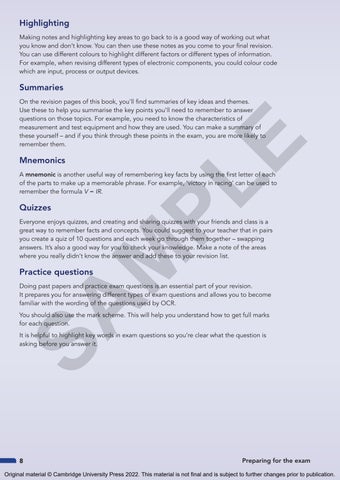Highlighting Making notes and highlighting key areas to go back to is a good way of working out what you know and don’t know. You can then use these notes as you come to your final revision. You can use different colours to highlight different factors or different types of information. For example, when revising different types of electronic components, you could colour code which are input, process or output devices.
Summaries
Mnemonics
PL E
On the revision pages of this book, you’ll find summaries of key ideas and themes. Use these to help you summarise the key points you’ll need to remember to answer questions on those topics. For example, you need to know the characteristics of measurement and test equipment and how they are used. You can make a summary of these yourself – and if you think through these points in the exam, you are more likely to remember them.
A mnemonic is another useful way of remembering key facts by using the first letter of each of the parts to make up a memorable phrase. For example, ‘victory in racing’ can be used to remember the formula V = IR.
Quizzes
M
Everyone enjoys quizzes, and creating and sharing quizzes with your friends and class is a great way to remember facts and concepts. You could suggest to your teacher that in pairs you create a quiz of 10 questions and each week go through them together – swapping answers. It’s also a good way for you to check your knowledge. Make a note of the areas where you really didn’t know the answer and add these to your revision list.
Practice questions
SA
Doing past papers and practice exam questions is an essential part of your revision. It prepares you for answering different types of exam questions and allows you to become familiar with the wording of the questions used by OCR. You should also use the mark scheme. This will help you understand how to get full marks for each question. It is helpful to highlight key words in exam questions so you’re clear what the question is asking before you answer it.
8
Preparing for the exam
Original material © Cambridge University Press 2022. This material is not final and is subject to further changes prior to publication.



